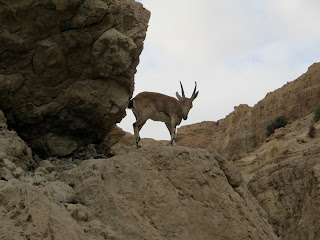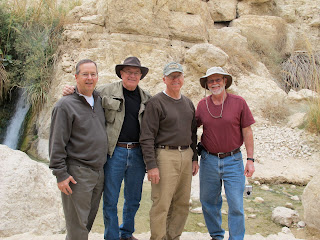CITY OF DAVID
The last stop of our visit to Israel was The City of David, here depicted by the sign of the harp, which is symbolic of David, the “Sweet Singer of Israel”.
Harp (City of David Symbol)
II Sam 24:16-24 records how David purchased the threshing floor of Araunah, the Jebusite, on Mount Moriah, in order to erect an altar and make sacrifices to God. This was the beginning of what became The City of David, shown here in an artistic representation.
City Of David
The excavation of The City of David is ongoing, and has revealed structures of amazing vertical dimensions. Note the ancient toilet in lower left.
Ancient Stone Wall, Stairway
HEZEKIAH'S TUNNEL
II Kings 20:20 and II Chronicles 32:30 are the key references. (See also II Samuel 5:8 for a mention of King David in this context.) Hezekiah chiseled this 1500-meter tunnel out of solid limestone – from both ends at once! – in order to route water from the Gihon Spring, which was outside the city walls, into the city. Water inside the city would enable victory over enemy siege.
Below, we are about to begin the great adventure of passing through Hezekiah’s Tunnel.
Group Entering Tunnel: Ron Scarbrough, Eddie Brown
Wesley Brown, Betty Scarbrough, Wyeth Luter & Bill Luter
The water came to mid-thigh at places and, at times, we had to stoop. Most of the way, it was not much wider than your shoulders. But, as you can see in the video below, it was a lot of fun!
The Pool of Siloam is at the end of the tunnel. This is where the man “blind from birth” was sent by Jesus to wash and receive his sight. (John 9:1-12)
Pool of Siloam
This newly excavated “step road” led from the Pool of Siloam all the way to the Temple Mount. Thus it is that the Lord Jesus Christ may have placed His feet on these very stones – they have not been restored in any way since being uncovered.
Stepped Road
As you can see from the title this is our last post. We headed to the airport later this day after changing into dry clothes. What a wonderful experience we had traveling through the land of the Bible and walking in the footsteps of Jesus. We want to thank Ron Scarbrough for all of the assistance he gave us in publishing these blogs and we hope you have enjoyed reading them. Many thanks too to Ken Sheppard for organizing and leading the trip -- it was definitely the "trip of a lifetime!"
Bill & Wyeth Luter






























































